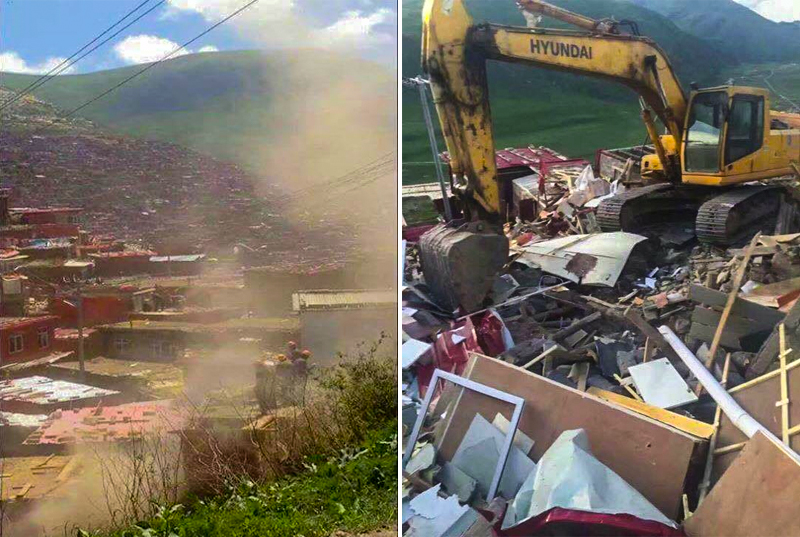 Dharamshala — Monks and nuns have watched helplessly as Chinese demolition teams have rolled into Serthar, Kardze and begun tearing down their homes at the Larung Gar institution, one of the world's largest monastic institutions with a population of over ten thousand Buddhist practitioners.
Dharamshala — Monks and nuns have watched helplessly as Chinese demolition teams have rolled into Serthar, Kardze and begun tearing down their homes at the Larung Gar institution, one of the world's largest monastic institutions with a population of over ten thousand Buddhist practitioners.
The demolitions come after an initial government order was issued in June demanding that "by September 30, 2017 the population of the encampment must be limited to 5,000 persons". The local authorities have marked up a map which indicates areas where homes are permitted and areas where they will be demolished. Around 1,400 houses are set to be demolished in the first wave and they are primarily nuns' homes and hostels belonging to elderly people.
No explanation for the demolitions was given in the order other than saying it is part of 'correction and rectification obligations'. It further states: "Residences of those expelled since 2013, illegal new residences, residences that have become old age homes and nuns' hostels, a total of 1,500, will be demolished at one go".
In statements made by the local authorities, they say that action against the institute is not specifically for demolition purposes and is instead part of construction development and a project for "accelerated urbanisation". The Serthar County United Front Work Department secretary, said: "Online it has been said that 'Larung Gar will be demolished,' 'it's the end of Larung Gar,' 'the monks and nuns will be removed,' 'the authorities are destroying and sweeping away a holy religious place,' and so on. This is totally untrue, and irresponsible."
He added that the work is part of the expansion of nearby Lo-Nor Township "because Larung Gar monastery is close to Lo-Nor township it will naturally be integrated into the overall planning and construction."
With the demolitions potentially causing and emotional or even angry response from residents, Tibetan lamas in charge of the institute have called for a calm response and advised those affected to continue with their studies and focus on Buddhist teachings, not the destruction of physical possessions.
A similar crackdown at Larung Gar was reported in 2001 and thousands of homes were dismantled by over 500 armed police and military personnel. Witnesses at the time said that huts were demolished with possessions and shrines still inside and demolition teams were seen to drag elderly and disabled residents out of their homes before destroying their homes, in some cases demolitions began while the owners were still inside. This crackdown is believed to have led to the expulsion of 8,000 practitioners and the demolition of 1,874 monastic residences and 2,000 meditation huts.
In a statement made after work began last week, Matteo Mecacci, president of the International Campaign for Tibet, said: "These demolitions are part of a set of policy measures implemented by the Chinese government that severely restrict the religious freedom of Tibetan Buddhists.
"This is a regressive and dangerous approach aimed at managing and controlling Tibetan Buddhism that sends a chilling signal to the outside world about the pressures faced by people seeking to peacefully practice their religion in the PRC. Larung Gar is a living, vital center of Tibetan Buddhist teachings that is renowned worldwide and across China. It is of immeasurable importance in terms of Tibetan language, culture and religion as well as for a new generation of Chinese Buddhist scholars and pilgrims. As such it should be treasured and protected, and its religious teachers must be fully engaged in decision-making on its long-term future."


![Tibet has a rich history as a sovereign nation until the 1950s when it was invaded by China. [Photo: File]](/images/stories/Pics-2024/March/Tibet-Nation-1940s.jpg#joomlaImage://local-images/stories/Pics-2024/March/Tibet-Nation-1940s.jpg?width=1489&height=878)















